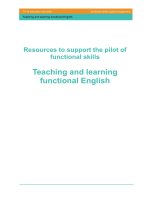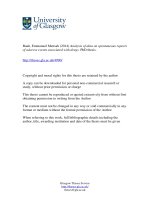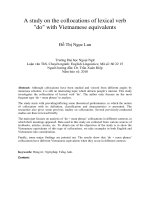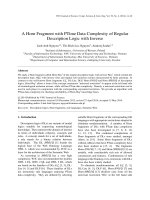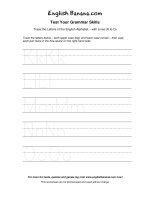Advanced control of active magnetic bearings with learning control schemes
Bạn đang xem bản rút gọn của tài liệu. Xem và tải ngay bản đầy đủ của tài liệu tại đây (1.43 MB, 127 trang )
ADVANCED CONTROL OF ACTIVE MAGNETIC
BEARINGS WITH LEANRING CONTROL SCHEMES
WU DEZHENG
(B.Eng., Shanghai Jiao Tong University)
A THESIS SUBMITTED
FOR THE DEGREE OF MASTER OF ENGINEERING
DEPARTMENT OF ELECTRICAL AND COMPUTER ENGINEERING
NATIONAL UNIVERSITY OF SINGAPORE
2004
i
Acknowledgements
Firstly I would like to express sincere gratitude and appreciation to my supervisor, Dr.
Bi Chao, for giving me challenging tasks to grow up, for his guidance and support,
for what I learned from him about knowledge and life. He provides me with sound
advice on my research works, nice suggestions on research methods, and valuable
information that broaden my vision on hard disk. I would like to regard him as my
role model in my future career.
I also wish to thank Dr. Liu Zhejie and Dr. Jiang Quan, my supervisors, for their
encouragement, support and directions during my graduate study in DSI.
Special thanks also go to: the lab officer Mr. Lim Choon Pio for helping me a lot in
laboratory despite his busy schedule in projects; my fellows Mr. Lin Song, Mr. Wei
Taile, and Mr. Huang Ruoyu for their help and remarks to my work as well as their
effort to make the laboratory an enjoyable place to work in.
I would also like to thank my parents, Mr. Wu Minglun and Ms. Su Zhongliang, not
only for bringing me up, but also for their endless support and care in the past 26
years.
Most sincerely, I wish to thank my wife, Ms. Jin Leilei. Her love, encouragement and
company over the years energize me to accomplish my Master study in a foreign
country.
Last but not least, I would like to thank Data Storage Institute for offering me
financial assistance and research facilities to finish this thesis.
Wu Dezheng
ii
Content
Summary v
List of Tables vii
List of Figures viii
Nomenclature xii
1. Introduction 1
1.1 Research Motivation 1
1.1.1 AMB for HDD Spindle Motors 1
1.1.2 Unbalance Effect 2
1.2 Introduction to AMB 4
1.2.1 Working Principle of AMB 4
1.2.2 4-DOF AMB 8
1.3 Analysis of Unbalance in AMB 9
1.3.1 Analysis of Mass Unbalance 9
1.3.2
Electromagnetic Unbalance
10
1.3.3 Composite Unbalance Effect 12
1.3.4 Compensation of Unbalance with AMB 13
1.4 Literature Review 14
1.4.1
Notch Filters
15
1.4.2
State Feedback Controllers and Observers
15
1.4.3
Adaptive Controllers
16
1.4.4
FILC and AVC
17
1.4.5
Other Advanced Control Methods
18
1.4.6
Discussions
18
1.5 Scope of the Thesis 19
2. Time-Domain Iterative Learning Control Scheme for Unbalance
Compensation 21
2.1 Iterative Learning Control 21
iii
2.1.1 Basic Idea of ILC 21
2.1.2 Time-Domain ILC 23
2.1.3 Low-Pass Filter and its Phase Lag 24
2.2 ILC Scheme for Unbalance Control in AMB 26
2.2.1 ILC Scheme for Rotation about Geometric Axis 26
2.2.2 ILC Scheme for Rotation about System Inertial Axis in AMB 27
2.2.3 Decentralized Control 28
3. Automatic Learning Control for Unbalance Compensation 30
3.1 Introduction of Automatic Learning Control 30
3.1.1 Process Synchronous Signals 31
3.1.2 Gain-Scheduled Control 32
3.1.3 Variable Learning Cycle 33
3.2 ALC scheme for Unbalance Compensation in AMB 35
4. Simulation Results 37
4.1 A 4-DOF AMB Model 37
4.2 Simulation of reducing rotor runout 42
4.2.1 Simulation Results with a Constant Speed 42
4.2.2 Simulation with speed fluctuations 46
4.3 Simulation Results of Current Fluctuation Reduction 50
5. Experimental Results 52
5.1 Experimental Setup 52
5.2 System Hardware 53
5.2.1 AMB Experimental System 53
5.2.2 dSAPCE DS1103 Controller Board 56
5.3 ILC Scheme for Unbalance Compensation 57
5.3.1 ILC Scheme for Rotor Runout Reduction 57
5.3.2 ILC Scheme for Reducing Coil Current Fluctuations 66
5.4 ALC Scheme for Rotor Runout Reduction 71
5.4.1 Experiment at the Speed of 2800 RPM 72
5.4.2 Variable speed Experiment for ALC Scheme 80
5.5 Reduction of Coil Currents Fluctuations by ALC 82
iv
5.5.1 Constant Speed Test 82
5.5.2 Variable Speed Test 88
5.6 Performance Comparison of ILC and ALC Schemes During Speed
Fluctuations 91
5.7 Observations and Discussions 97
6. Conclusions and Future Works 99
6.1 Conclusions 99
6.2 Future Works 103
Bibliography 104
List of Publications 113
v
Summary
Unbalance effect is a common problem in rotating machinery. When the rotor’s
geometric axis, inertial axis and magnetic axis are not coincident, the unbalance
happens and it can cause undesirable vibrations, acoustic noise and rotor position
runout. Runout is a term that describes the motion of a rotating shaft in radial
directions. Existence of such motion, repetitive or non-repetitive, in precision
spindles (such as disk drive motors) is generally detrimental to their applications.
Active magnetic bearing (AMB), which levitates a rotating object (typically, a rotor
in electric machine) with a magnetic field, is proven to be a good solution to this
unbalance problem. With effective control methods, the unbalance effect can be
greatly attenuated in the machines using AMB.
In this thesis, a time-domain iterative learning control (ILC) scheme is firstly applied
in AMB to realize unbalance compensation. Then a new control scheme, automatic
learning control (ALC), is proposed to achieve better performance in unbalance
control, and it works in a wide range of rotational speeds in AMB. ALC is based on
the combination of time-domain ILC and gain-scheduled control, and is able to adjust
itself to different rotational speeds. Since ALC can work at different rotational speeds,
the negative effect of speed fluctuations on the ILC scheme doesn’t appear in ALC
scheme. The unbalance compensation is carried out in two modes. One is to achieve
rotation about rotor’s geometric axis with the benefit of precise positioning. The other
is to achieve rotation about rotor’s inertial axis, resulting in reduced transmitted force
vi
to the bearing housing and vibrations. In this thesis, both compensation modes are
realized with ILC and ALC.
Simulations and experiments are carried out to verify the effectiveness of ILC and
ALC schemes. Simulations and experimental results prove that both ILC and ALC
can effectively compensate the unbalance force in AMB, and ALC has better
performance in presence of fluctuations in speed. Rotor position runouts and
fluctuations of coil currents in all radial degree-of-freedom are substantially
attenuated.
vii
List of Tables
Table 4.1 Simulation parameters
42
Table 4.2 Performance comparisons of the three controllers
49
Table 5.1
Comparison between ILC and ALC during speed fluctuations (1) 94
Table 5.2
Comparison between ILC and ALC during speed fluctuations (2) 96
viii
List of Figures
Fig. 1.1 An electromagnet
4
Fig. 1.2
Structure of a 2-DOF magnetic bearing 6
Fig. 1.3
Structure of a PM-biased AMB 7
Fig. 1.4
4-DOF magnetic suspensions 9
Fig. 1.5
Mass Unbalance 10
Fig. 1.6
Magnetic Unbalance 11
Fig. 2.1
Typical Iterative Learning Control 22
Fig. 2.2
Results of the phase delay and compensation of the filter 25
Fig. 2.3
Proposed time-domain ILC scheme 25
Fig. 2.4
ILC scheme for rotation about geometric axis. 27
Fig. 2.5
ILC scheme for rotation about system inertial axis. 28
Fig. 2.6
Decentralized control mode for ILC scheme 29
Fig. 3.1
Functional block diagram of processing synchronous signal. 32
Fig. 3.2
Automatic Learning Control Scheme 34
Fig. 3.3
ALC Scheme for Rotation about Geometric Axis 35
Fig. 3.4
ALC scheme for Rotation about System Inertial Axis 36
Fig. 4.1
Radial bearing 1 and 2 37
Fig. 4.2
Transient Response of rotor runout with ILC 43
Fig. 4.3
Steady-state rotor runout without unbalance compensation. 44
Fig. 4.4
Steady-state rotor runout with ILC 44
Fig. 4.5
Transient response of rotor runout with ALC. 45
ix
Fig. 4.6
Steady-state rotor runout with ALC. 45
Fig. 4.7
Transient response of rotor runout when α = 0. 46
Fig. 4.8
Transient response of ILC with a zero forgetting factor 47
Fig. 4.9
Transient response of ILC with a forgetting factor of 0.005 48
Fig. 4.10
Transient response of ALC with α = 0.005 49
Fig. 4.11 Transient response of control current with ILC scheme
51
Fig. 4.12 Transient response of control current with ALC scheme
51
Fig. 5.1
Configuration for the AMB unbalance control experiment 53
Fig. 5.2
The AMB machine in experiments 54
Fig. 5.3
The structure of the AMB machine. 55
Fig. 5.4
A radial bearing 55
Fig. 5.5
Rotor position orbit of bearing 1 without ILC 58
Fig. 5.6
Rotor position orbit of bearing 1 with ILC 58
Fig. 5.7
Rotor position orbit of bearing 2 without compensation 59
Fig. 5.8
Rotor position orbit of bearing 2 with ILC 59
Fig. 5.9
Rotor position orbit with ILC when rotational speed has fluctuations. 60
Fig. 5.10
Rotor runout in Axis X1 and its frequency spectrum. 61
Fig. 5.11
Rotor runout in axis Y1 and its frequency spectrum. 62
Fig. 5.12
Rotor runout in axis X2 and its frequency spectrum. 63
Fig. 5.13
Rotor runout in axis Y2 and its frequency spectrum. 64
Fig. 5.14
Fluctuation of coil current in axis X1 and its frequency spectrum. 67
Fig. 5.15
Fluctuation of coil current in axis Y1 and its frequency spectrum. 68
Fig. 5.16
Fluctuation of coil current in axis X2 and its frequency spectrum. 69
x
Fig. 5.17
Fluctuation of coil current in axis Y2 and its frequency spectrum. 70
Fig. 5.18
Rotor position orbit of bearing 1 without ALC. 73
Fig. 5.19
Rotor position orbit of bearing 1 with ALC scheme. 73
Fig. 5.20
Rotor position orbit of bearing 2 with ALC scheme. 74
Fig. 5.21
Rotor position orbit of bearing 2 with ALC scheme. 74
Fig. 5.22
Rotor runout in X1 axis and its frequency spectrum. 76
Fig. 5.23
Rotor runout in Y1 axis and its frequency spectrum. 77
Fig. 5.24
Rotor runout in X2 axis and its frequency spectrum. 78
Fig. 5.25
Rotor runout in Y2 axis and its frequency spectrum. 79
Fig. 5.26
Axis X1 position runout vs rotational speeds. 80
Fig. 5.27
Axis Y1 position runout vs rotational speeds. 81
Fig. 5.28
Axis X2 position runout vs rotational speeds. 81
Fig. 5.29
Axis Y2 position runout vs rotational speeds. 82
Fig. 5.30
Fluctuation of coil current in axis X1 and its frequency spectrum. 84
Fig. 5.31
Fluctuation of coil current in axis Y1 and its frequency spectrum. 85
Fig. 5.32
Fluctuation of coil current in axis X2 and its frequency spectrum. 86
Fig. 5.33
Fluctuation of coil current in axis Y2 and its frequency spectrum. 87
Fig. 5.34
Fluctuation of axis X1 coil current vs rotational speeds. 88
Fig. 5.35
Fluctuation of axis Y1 coil current vs rotational speeds. 89
Fig. 5.36
Fluctuation of axis X2 coil current vs rotational speeds. 89
Fig. 5.37
Fluctuation of axis Y2 coil current vs rotational speeds. 90
Fig. 5.38
Comparison of effective control current. 91
Fig. 5.39
Rotor runout at 3000rpm. 92
xi
Fig. 5.40
Rotor runout at 3010rpm. 93
Fig. 5.41
Fluctuation of coil current in axis X1
at 3000rpm. 95
Fig. 5.42
Fluctuation of coil current at 3010rpm. 96
xii
Nomenclature
AMB Active magnetic bearing
ILC Iterative learning control
ALC Automatic learning control
DOF Degree-of-freedom
HDD Hard disk drive
NRRO Non-repeatable runout
FDB Fluid dynamic bearing
TPI Track per inch
EM Electromagnetic
PWM Pulse width modulation
PM Permanent magnet
AFB Adaptive forced balancing
CPU Central processing unit
FILC frequency-domain iterative learning control
AVC Adaptive vibration control
DSP Digital signal processor
PID Proportional-integral-differential
A/D Analog-to-digital
D/A Digital-to-analog
PC Personal computer
I/O Input/output
xiii
MCM Multi-chip module
1
1. Introduction
This chapter discusses the motivation of the research on Active Magnetic Bearing
(AMB) and provides background knowledge on AMB and unbalance effect. The
reasons to cause unbalance effect are analyzed. Various existing unbalance control
methods for AMB are reviewed. In addition, their advantages and limitations are also
discussed.
1.1 Research Motivation
1.1.1 AMB for HDD Spindle Motors
Following the rapid developments of magnetic hard disk drives (HDD) in recent years,
all the components used in hard disk drive are facing challenges for realizing high-
density data recording. One of the bottlenecks in limiting the data recording density is
spindle motor. The vibrations and non-repeatable runout (NRRO) of the motor limit
the track density in data recording. They also cause acoustic noise in HDD operation.
So far, all the solutions for reducing vibrations and NRRO are based on mechanical
methods, for example, using precision ball bearings and fluid dynamic bearings
(FDB). Success of these mechanical solutions relies heavily on the development of
precision machining technology. The track density, i.e., the tracks-per-inch or TPI of
HDDs has increased rapidly in past years, and will be increased further in the coming
Chapter 1. Introduction
2
years. This will make it difficult to meet more strict requirements of HDDs in future
using mechanical solutions. Many potential bearing solutions are considered by HDD
researchers, and the contact free suspension by AMB is one of them. Comparing with
the ball bearing and FDB spindle motors, spindle motors using AMB have the
following advantages
(1) Absence of mechanical friction and wear. Therefore, the motor lifetime can be
increased, and the vibration and acoustic noise of the motor can be reduced.
(2) No lubricant leakage problem, which is a very big concern in HDD.
(3) AMB’s performance is not very sensitive to the precision in dimension of
components. As the rotor movement is controlled by an electric system, for
the same precision, AMB is able to show better performance in the runout and
vibration.
(4) AMB is an electronics solution to the high performance rotational system. Its
performance can be improved significantly following the fast developments of
electronics technology and advanced control methods.
1.1.2 Unbalance Effect
Research on AMB includes Electromagnetic (EM) design, sensing technology, and
control techniques. The aim of this research project is to investigate the control
techniques of AMB, and to provide the foundation for employing AMB in the next
generation of HDD. This thesis focuses on performance improvement of AMB by
utilizing control methods without additional manufacturing complexity.
Chapter 1. Introduction
3
Unbalance is a common problem in rotating machinery. When a rotor’s geometrical
axis does not align with the axis of inertia and the axis of electromagnetic field, the
unbalance force is induced. This unbalance force is transmitted to the stator and
housing through the bearing, resulting in serious vibration and acoustic noise,
especially at critical speeds of the rotor [1]. Furthermore, the position runout of the
rotor makes it difficult to realize precise positioning and high-speed operation. In
HDD area this brings difficulties to achieve accurate data reading/writing.
Rotor unbalance results from rotor asymmetry in shape, material non-uniformity,
asymmetric EM parameters, misalignment of bearings, asymmetric rotor
deformations, etc. As perfect rotor system without unbalance is almost impossible,
rotor balancing technique must be used in high standard applications.
The conventional method of balancing is realized by employing mechanical
approaches, for example, the addition or removal of small amount of mass from the
rotor to reduce the residual imbalance. This is a time consuming and costly procedure.
Besides, the imbalance in some machines often changes during operation, and
mechanical balancing has limited benefit in such case. Moreover, this mechanical
balancing is not practical for mass production, such as in the HDD spindle motor area.
Recently active magnetic bearing is proven to be a good solution to the unbalance
problem. Through effective control methods, the unbalance effect can be greatly
attenuated in machines using AMB. In this thesis the unbalance compensation
techniques will be investigated and a suitable control method will be proposed for
AMBs used in HDD spindle motors.
Chapter 1. Introduction
4
1.2 Introduction to AMB
In contrast to conventional bearings, AMB uses EM forces to actively levitate the
rotor without any mechanical contact. Due to its attractive features, AMB has been
applied in a variety of applications such as turbomachinery [2]- [4], flywheels [5]- [7],
artificial blood pumps [8], machine tool spindles [9], vacuum pumps [10], [11], etc.
Spindle motor in HDD is also a potential application of AMB and it has attracted wide
attentions in recent years [12]- [14].
1.2.1 Working Principle of AMB
AMB uses EM forces to levitate rotors and controls their motions. The rotors are usually
made of ferromagnetic materials, and some contain permanent-magnetic (PM)
materials. An AMB system consists of EM actuators, position sensors, controller, and
amplifiers. Position sensors measure rotor positions and send position signals to the
controller. Then the controller uses some control algorithm to generate corresponding
control current signals. Power drives, usually using PWM technology, send current to
electromagnets to produce resulting control force such that the rotor is stably
suspended without any mechanical contact with the stator.
A
g
N, i
Fig. 1.1. An electromagnet
Chapter 1. Introduction
5
Suppose an electromagnet has N turns of coil, i is the coil current in this
electromagnet. A is its effective cross-area, and g is the air gap. The magnetic field is
considered to distribute evenly under the magnetic pole. The EM force in this axis is
therefore [10]
2
22
0
22
4
m
NA
ii
fK
g
g
µ
=⋅=⋅
(1.1)
where,
2
0
4
m
NA
K
µ
(1.2)
and the permeability of free space is
7
0
410H/m
µπ
−
=× .
Usually two electromagnets are oppositely located in one DOF, so the EM force in
this DOF is
22
12
22
00
()()
mm
ii
fK
s
sss
⎛⎞
⎟
⎜
⎟
= ⋅−
⎜
⎟
⎜
⎟
⎜
− +
⎝⎠
, (1.3)
where i
1
, i
2
are coil current in electromagnets, s
0
is length of the air gap when the
rotor is in the center position, s is the rotor displacement with respect to the bearing
center in this axis. Thus (s
0
– s) and (s
0
+ s) are respectively the lengths of the air gaps
for the two opposite electromagnets.
The typical structure of a 2-DOF radial magnetic bearing is shown in Fig. 1.2.
Chapter 1. Introduction
6
ROTOR
controller
Electromagnets
Amplifier
Position
sensor
i
1
i
2
Fig. 1.2. Structure of a 2-DOF magnetic bearing
The two opposite electromagnets are operated in the so-called differential driving
mode. In this mode, the coil current in one electromagnet is the sum of bias current i
0
and control current i
c
, the coil current in the other electromagnet is the difference of
bias current and control current, as shown in (1.4).
10 20
,
cc
iiiiii=+ =− (1.4)
For the reasons explained later, i
0
is normally not zero in many applications. The
existence of a non-zero bias current has an obvious advantage that the EM force in
(1.3) can be linearized at the equilibrium point (i
c
= i
c0
, s = 0)
mics
f
Ki K s=⋅+⋅
. (1.5)
0
0
2
0
,0
4
cc
m
im
c
iis
K
i
Kf
is
==
∂
=
∂
(1.6)
0
22
00
3
,0
0
4( )
cc
mc
sm
iis
K
ii
Kf
ss
==
+
∂
=
∂
(1.7)
Chapter 1. Introduction
7
In PM-biased AMB (See Fig. 1.3, [15]), bias flux that generated by permanent
magnets replaces bias current in conventional AMB to produce the same effect, so its
coil currents in the two opposite electromagnets are
12
,
cc
iii i==− (1.8)
The EM force formula of PM-biased AMB has the same format as (1.5). The
difference is that for a PM-biased AMB the force-current factor K
i
and force-
displacement factor K
s
are related to permanent magnet parameters instead of the bias
current [15], [16]. Although in these years, nonlinear control techniques have been
introduced to eliminate the bias current or flux [17]- [19], there is still a lot of work to
do before zero-bias control technique can be applied in industry. As a result, the
differential driving mode, including PM-biased flux mode, is still used in our research
works.
Fig. 1.3.
Structure of a PM-biased AMB
From (1.7), -K
s
can be regarded as the open-loop stiffness of AMB. From (1.2) and
(1.7), it is obvious that
0, 0
ms
KK>> (1.9)
Chapter 1. Introduction
8
The open-loop AMB system has a negative stiffness, so AMB is open-loop unstable
and therefore appropriate control strategies must be employed to stabilize the AMB
system.
According to Newton’s Law, the motion of the rotor with mass m can be described by
mu ic s u
f
fKiKsf
s
mm
+⋅+⋅+
==
(1.10)
where
f
u
is the disturbance force in this DOF.
The state equation for AMB is
()
01 0 0
0
10
c
siu
ss
i
K
Kf
ss
mmm
s
y
s
⎛⎞⎛⎞⎛⎞
⎛⎞ ⎛⎞
⎜⎟⎜⎟⎜⎟
=++
⎜⎟ ⎜⎟
⎜⎟⎜⎟⎜⎟
⎜⎟⎜⎟⎜⎟
⎝⎠ ⎝⎠
⎝⎠⎝⎠⎝⎠
⎛⎞
=
⎜⎟
⎝⎠
(1.11)
Thus by employing appropriate control algorithm, the AMB system can be stabilized.
1.2.2 4-DOF AMB
A totally suspended magnetic bearing system is composed of 5-DOF suspensions, 4
radial DOF controlled by radial bearings and an axial DOF controlled by a thrust
bearing. An AMB system is usually arranged such that the axial subsystem can be
separated from the other 4 radial subsystems. So, the axial motion can be individually
considered and the motion equation has a simple double integrator format. Because
the unbalance effect in radial directions is the major concern in many applications,
e.g., HDD, only motions of radial bearings are considered in the thesis.
Chapter 1. Introduction
9
Fig. 1.4. 4-DOF magnetic suspensions
A standard 4-DOF magnetic suspension of the rotor is illustrated in Fig. 1.4. There
are two radial bearing planes for an AMB system. Each radial plane includes 2-DOF
magnetic suspensions. Therefore the AMB system in our research is a 4-input-4-
output system.
1.3 Analysis of Unbalance in AMB
In recent years, some problems on AMB are concerned by researchers such as micro-
AMB, self-sensing techniques, unbalance problems, and nonlinear control techniques,
etc. The unbalance problem is analyzed in this thesis and a control solution will be
proposed to solve this problem.
1.3.1 Analysis of Mass Unbalance
Fig. 1.5 describes the mass unbalance effect in AMB when rotor’s geometric axis is
not coincident with its inertial axis.
Chapter 1. Introduction
10
Fig. 1.5.
Mass Unbalance
Consider in a 2-D plane, with mass eccentricity
1
ε
, rotor’s angular speed ω, the
unbalance force due to mass eccentricity can be modeled as
2
1
cos( )
mx
fm t
εω ω θ
=+
(1.12)
2
1
sin( )
my
fm t
εω ω θ
=+ (1.13)
where θ is the initial phase of mass unbalance.
1.3.2 Electromagnetic Unbalance
Besides mass unbalance, there also exists EM unbalance in AMB when the geometric
axis doesn’t coincide with the EM axis, as shown in Fig. 1.6. In Fig. 1.6, O
mag
is the
magnetic center in the cross section of AMB, O
gm
is the geometric center in this cross
section,
2
ε
is the EM eccentricity, α is the initial phase angle of the eccentricity, x
1
and x
2
are the air gaps in axis X, y
1
and y
2
are the air gaps in axis Y.
Chapter 1. Introduction
11
Fig. 1.6.
Magnetic Unbalance
If the EM center coincides with the geometric center, air gaps in the axis X should be
s
0
. Otherwise, the air gaps in axis X are as follows
102
cos( )xs t
εωα
=− + (1.14)
202
cos( )xs t
εωα
=+ +
(1.15)
Assuming
02
se , the EM unbalance force in axis X is
2
cos( )
ex s
fK t
εωα
=+
. (1.16)
Likewise, the air gaps in axis Y are
102
sin( )ys t
εωα
=− + (1.17)
202
sin( )ys t
εωα
=+ +
(1.18)
and the EM unbalance force in Y axis is
2
sin( )
ey s
fK t
εωα
=+
. (1.19)
(1.14)−(1.19) are based on the assumption that the cross section of the rotor is
perfectly round. Otherwise higher-order harmonic components would appear in the
